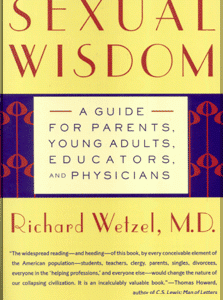Health Problems associated with
Hormonal Birth Control
by
Dr. Rebecca Peck
Dr. Benjamin Peck
Fr. Juan R. Vélez, former MD
Updated by Liliana Cote de Bejarano, MD, MPH
Oral birth control (and all other hormonal birth control—HBC) is typically used to prevent pregnancy but is sometimes prescribed for other medical conditions. HBC causes many potential adverse effects: medical, social and spiritual. The vast majority of HBC prescriptions are given by physicians to healthy women, including adolescents with no known disease. Some women are prescribed hormonal birth control for only one reason—to prevent the completely normal condition of pregnancy.
Since all medications have potentially unwanted side effects, some of them serious, it is important that a physician weigh the risks and benefits when prescribing any medication. It follows that it is unethical to expose healthy women to health risks in order to prevent a normal condition. The mistake of exposing women to these risks is quite grave since other methods of family planning exist, like Natural Family Planning (NFP), which have no side effects.
As physicians, we do not prescribe hormonal birth control. The medical reasons for this decision are as follows:
HBC Treats Women’s Fertility and
Childbearing as a Disease
Although there can be legitimate medical and personal reasons for avoiding pregnancy, female fertility and the possibility of pregnancy itself are not diseases, and therefore do not need a pill (or patch, shot, IUD) for “treatment.”
HBC Causes Abortion
When HBC fails to suppress ovulation and other mechanisms of action that impede fertilization in a sexually active woman, conception may occur. HBC interferes with the implantation of a new human being by reducing the thickness of the lining of the uterus and altering implantation molecules and factors.1
Typical low dose HBC formulations only prevent the release of the female egg in about 65-75% of cycles.2,3
For this reason, if a woman has intercourse in her fertile phase, pregnancy and subsequent chemical abortion is possible in approximately 30% of the cycles.
HBC Contributes to an
Anti-Life Mentality
HBC (whether the Pill, patch, IUD or Shot) underpins the practice of abortion. People unwittingly conclude: “If birth control fails, abortion is the solution.” A nation-wide survey indicated that 54% of the women who had an abortion were using birth control the month before.4
HBC Increases the Risk of
Breast Cancer
Women face an increased risk of developing breast cancer while taking HBC and for at least ten years after the use of HBC is stopped. According to a study published in The New England Journal of Medicine using hormonal contraception for 10 years increases the risk of breast cancer by 38%. Additionally, the study showed that IUDs that release hormones also increase the risk for breast cancer.5 If the Pill is taken for four years before a woman’s first pregnancy, there is a 52% increased risk of breast cancer.6 An analysis of multiple studies noted that 21 out of 23 retrospective studies showed an increased risk of premenopausal breast cancer in women who took oral contraceptives prior to the birth of their first child.7
HBC Increases the Risk of
Blood Clots
A study of 1524 patients in the Netherlands concluded that hormonal contraceptives increased the risk of venous thrombosis fivefold compared with non-use.8 The risk is highest for HBC-using women who are overweight, smoke or are over 35 years of age.9
A recent systematic review reported that the use of combined oral contraceptives increased the risk of venous thrombosis fourfold compared to women who never used oral contraceptives.10
HBC increases the Risk of Suicide and Causes Changes in Healthy Body Metabolism
The study of almost half a million Danish women (2017) followed on average of 8.3 years concluded
that there was almost a twofold increased risk of suicide attempts in women using HBC. Also, there was a threefold increase in the risk of suicide in women using HBC compared to women who never use contraception.11 A recent study reported that the use of oral, vaginal, or transdermal HBC induced an increase in markers of chronic inflammation, a risk factor for cardiovascular disease. The use of combined contraceptives also impairs insulin sensitivity in young healthy women, which is a risk factor for diabetes mellitus.12 Additionally, HBC can produce migraine headaches, weight increase, moodiness, and loss of libido. It contributes to early increased bone loss.13The use of HBC is associated with infertility after prolonged use, and even to some extent with short-term use.
HBC Increases the Incidence of
Reproductive Organ Cancer
The use of HBC is associated with a significant increase in cancer of the cervix.14 It is likely that this follows infection with Human Papilloma Virus (HPV) which is a sexually transmitted infection.
HBC Increases the Risk of
Liver Tumors
There is some evidence that oral birth control increases the risk of certain benign and malignant liver tumors.15
HBC Increases the Risk of
Heart Attacks
First and second-generation oral birth control formulations have been linked to an increased risk of heart attacks (myocardial infarctions) and ischemic strokes.16 Third-generation oral birth control pills are associated with an increased risk of ischemic stroke.17 A 2015 analysis of multiple studies showed that women using combined oral contraceptive pills have a 1.6-fold increased risk to suffer heart attack or stroke.18
Harmful Effects of HBC on
Marriage and Society
Hormonal birth control fosters the mentality that men and women are incapable of self-control and are thus not able to abstain from sexual intercourse. The introduction of HBC was the catalyst for the sexual revolution with dramatic increases in premarital sex, adultery, divorce, abortion, and out-of-wedlock births. HBC has played an indirect role in the dramatic increase in single-parent families, poverty, and associated social ills in the U.S.19,20
Natural Family Planning (NFP) is an excellent way to plan your family
NFP is free of harmful side effects to women and families, and when used for just and serious reasons, can be very good for married couples. 21
References
- Klipping, C., Duijkers, I., Fortier, M. P., Marr, J., Trummer, D., & Elliesen, J. (2012). Long-term tolerability of ethinylestradiol 20 mug/drospirenone 3 mg in a flexible extended regimen: Results from a randomised, controlled, multicentre study.The Journal of Family Planning and Reproductive Health Care, 38(2), 84-93. doi:10.1136/jfprhc-2011-100214 [doi]
- Chowdhury, V., Joshi, U. M., Gopalkrishna, K., Betrabet, S., Mehta, S., & Saxena, B. N. (1980). ‘Escape’ ovulation in women due to the missing of low dose combination oral contraceptive pills.Contraception, 22(3), 241-247. doi:S0010-7824(80)80003-5 [pii]
- Baerwald AR, et al. Effects of oral contraceptives administered at defined stages of ovarian follicular development. Fertil Steril. 2006 Jul; 86(1): 27-35. Epub 2006 Jun 9.
- Jones, RK ,et al. Contraceptive use among U.S. women having abortions in 2000-2001. Perspec Sex Reprod Health. 2002; 34(6): 294-303.
- Morch, L. S., Skovlund, C. W., Hannaford, P. C., Iversen, L., Fielding, S., & Lidegaard, O. (2017). Contemporary hormonal contraception and the risk of breast cancer.The New England Journal of Medicine, 377(23), 2228-2239. doi:10.1056/NEJMoa1700732 [doi]
- Kahlenborn C. Breast Cancer, Its Link to Abortion and the Birth Control Pill. 2000.
- Kahlenborn, C., Modugno, F., Potter, D. M., & Severs, W. B. (2006). Oral contraceptive use as a risk factor for premenopausal breast cancer: A meta-analysis.Mayo Clinic Proceedings, 81(10), 1290-1302. doi:S0025-6196(11)61152-X [pii]
- van Hylckama Vlieg, A., Helmerhorst, F. M., Vandenbroucke, J. P., Doggen, C. J., & Rosendaal, F. R. (2009). The venous thrombotic risk of oral contraceptives, effects of oestrogen dose and progestogen type: Results of the MEGA case-control study.BMJ (Clinical Research Ed.), 339, b2921. doi:10.1136/bmj.b2921 [doi]
- Poulter, N. R. (2000). Risk of fatal pulmonary embolism with oral contraceptives.Lancet (London, England), 355(9221), 2088-6736(00)02369-2. doi:S0140-6736(00)02369-2 [pii]
- de Bastos, M., Stegeman, B. H., Rosendaal, F. R., Van Hylckama Vlieg, A., Helmerhorst, F. M., Stijnen, T., & Dekkers, O. M. (2014). Combined oral contraceptives: Venous thrombosis.The Cochrane Database of Systematic Reviews, (3):CD010813. doi(3), CD010813. doi:10.1002/14651858.CD010813.pub2 [doi]
- Skovlund, C. W., Morch, L. S., Kessing, L. V., Lange, T., & Lidegaard, O. (2018). Association of hormonal contraception with suicide attempts and suicides.The American Journal of Psychiatry, 175(4), 336-342. doi:10.1176/appi.ajp.2017.17060616 [doi]
- Piltonen, T., Puurunen, J., Hedberg, P., Ruokonen, A., Mutt, S. J., Herzig, K. H.,…Tapanainen, J. S. (2012). Oral, transdermal and vaginal combined contraceptives induce an increase in markers of chronic inflammation and impair insulin sensitivity in young healthy normal-weight women: A randomized study. Human Reproduction (Oxford, England), 27(10), 3046-3056.
- Wooltorton, E. (2005). Medroxyprogesterone acetate (depo-provera) and bone mineral density loss.CMAJ : Canadian Medical Association Journal = Journal De l’Association Medicale Canadienne, 172(6), 746. doi:cmaj.050158 [pii]
- La Vecchia, C., & Boccia, S. (2014). Oral contraceptives, human papillomavirus and cervical cancer.European Journal of Cancer Prevention: The Official Journal of the European Cancer Prevention Organisation (ECP), 23(2), 110-112. doi:10.1097/CEJ.0000000000000000 [doi]
- Giannitrapani, L., Soresi, M., La Spada, E., Cervello, M., D’Alessandro, N., & Montalto, G. (2006). Sex hormones and risk of liver tumor.Annals of the New York Academy of Sciences, 1089, 228-236. doi:1089/1/228 [pii]
- Tanis, B. C., van den Bosch, M. A., Kemmeren, J. M., Cats, V. M., Helmerhorst, F. M., Algra, A., . . . Rosendaal, F. R. (2001). Oral contraceptives and the risk of myocardial infarction.The New England Journal of Medicine, 345(25), 1787-1793. doi:10.1056/NEJMoa003216 [doi]
- Baillargeon, J. P., McClish, D. K., Essah, P. A., & Nestler, J. E. (2005). Association between the current use of low-dose oral contraceptives and cardiovascular arterial disease: A meta-analysis.The Journal of Clinical Endocrinology and Metabolism, 90(7), 3863-3870. doi:jc.2004-1958 [pii]
- Roach, R. E., Helmerhorst, F. M., Lijfering, W. M., Stijnen, T., Algra, A., & Dekkers, O. M. (2015). Combined oral contraceptives: The risk of myocardial infarction and ischemic stroke.The Cochrane Database of Systematic Reviews, (8):CD011054. doi(8), CD011054. doi:10.1002/14651858.CD011054.pub2 [doi]
- Akerlof, GA, et al. An analysis of out-of-wedlock childbearing in the United States. Q J Econ. 1996 May; 111(2):277-317.
- Akerlof, GA. Men without children. Econ J. 1998 Mar; 108(447): 287-309.
- Fehring, R. J. (2015). The influence of contraception, abortion, and natural family planning on divorce rates as found in the 2006-2010 national survey of family growth.The Linacre Quarterly, 82(3), 273-282. doi:10.1179/2050854915Y.0000000007 [doi]
Where can you learn more about
Natural Family Planning?
Billings Ovulation Method Association-USA
(888) 637-6371 www.Boma-usa.org
Couple to Couple League
(800) 745-8252 www.ccli.org
Family of the Americas Foundation
(800) 443-3395 www.familyplanning.net
FertilityCare Centers of America
(402) 390-6600, ext. 117 www.fertilitycare.org
Marquette Model
(414) 288-3854 www.NFP.Marquette.edu
Natural Family Planning International
(361-384-0067) www.NFPandmore.org
Northwest Family Services
(503) 215-6377 www.nwfs.org
US Conference of Catholic Bishops
(202) 541-3240 www.usccb.org
One More Soul
(800) 307-7685 www.OneMoreSoul.com

Problems Associated with Hormonal Birth Control
Four physicians who do not prescribe hormonal birth control give medical reasons for this decision.






